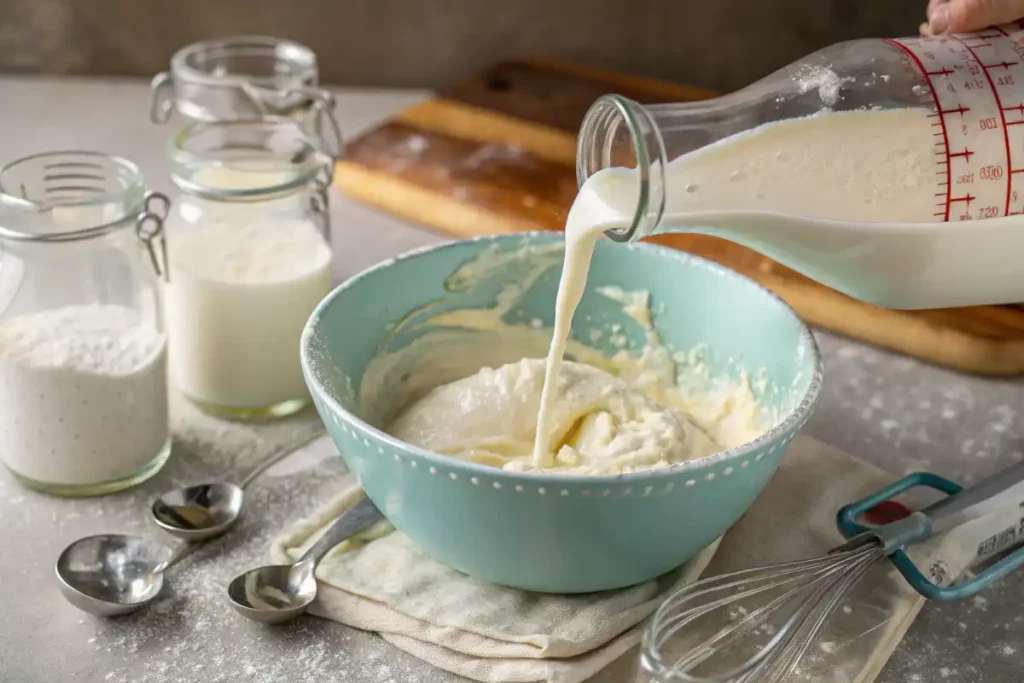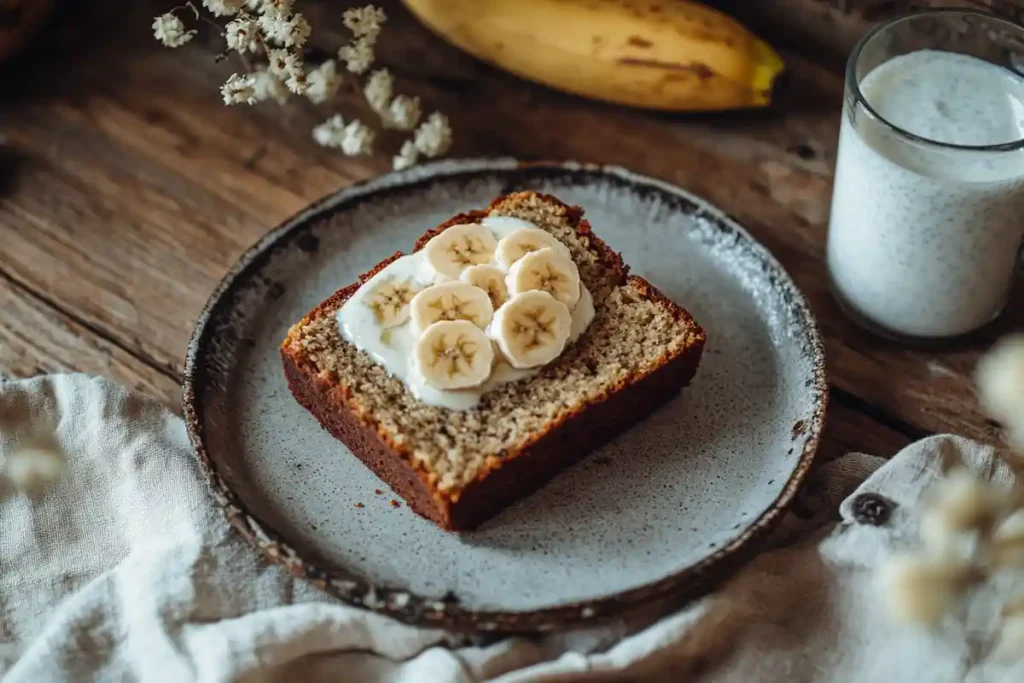Baking is both an art and a science, and choosing the right ingredients can make all the difference. For those seeking alternatives to milk, kefir often comes up as a unique, healthful, and flavorful substitute. But how does kefir stack up in the world of baking? Can it really replace milk seamlessly, or does it come with caveats? This article dives deep into the properties of kefir, why it’s gaining popularity as a baking ingredient, and how to make the switch in your favorite recipes. By the end, you’ll have all the insights you need to confidently substitute Kefir for Milk in Baking.
1. Understanding Kefir and Its Composition
What is Kefir?
Kefir is a fermented dairy product with origins in the Caucasus Mountains, where it’s been cherished for centuries. Made by fermenting milk with kefir grains—tiny colonies of bacteria and yeast—it has a tart, tangy flavor and a slightly effervescent texture. Think of it as a cross between yogurt and buttermilk but with a more robust microbial profile. It’s packed with probiotics, which are beneficial bacteria that support gut health.
Its nutritional profile makes it a standout. Kefir is rich in calcium, protein, vitamins B12 and K2, magnesium, and beneficial compounds like lactic acid. Plus, its fermentation process reduces lactose, making it easier for people with mild lactose intolerance to enjoy.
Key Properties of Kefir Relevant to Baking
When it comes to baking, the unique properties of kefir are what make it a game-changer. Here’s why:
- Fermentation and Acidity: Kefir is acidic, similar to buttermilk or yogurt. This acidity reacts with leavening agents like baking soda, helping baked goods rise and develop a tender crumb.
- Moisture Content: Its liquid consistency adds moisture to batters and doughs, resulting in softer, fluffier baked goods.
- Nutritional Boost: Unlike regular milk, kefir brings probiotics and extra nutrients into your recipes, enhancing both the flavor and health benefits.
Nutritional Content of Kefir (per 100g)
Kefir is not just a tasty addition to your baked goods; it’s also a nutrient-dense option that enhances the health benefits of your recipes. Below is the nutritional content of kefir per 100 grams:
| Nutrient | Amount per 100g |
|---|---|
| Calories | 60 kcal |
| Protein | 3.3 g |
| Fat | 3.2 g |
| Carbohydrates | 4.5 g |
| Sugar | 3.9 g |
| Calcium | 120 mg |
| Vitamin B12 | 0.4 µg |
| Probiotics | Varies (rich source) |
Key Properties of Kefir Relevant to Baking
When it comes to baking, the unique properties of kefir are what make it a game-changer. Here’s why:
- Fermentation and Acidity: Kefir is acidic, similar to buttermilk or yogurt. This acidity reacts with leavening agents like baking soda, helping baked goods rise and develop a tender crumb.
- Moisture Content: Its liquid consistency adds moisture to batters and doughs, resulting in softer, fluffier baked goods.
- Nutritional Boost: Unlike regular milk, kefir brings probiotics and extra nutrients into your recipes, enhancing both the flavor and health benefits.
Because of these characteristics, kefir isn’t just a replacement—it’s an upgrade in many baking applications.
2. Why Substitute Kefir for Milk in Baking?
Health Benefits of Using Kefir in Baking
One of the standout reasons to use kefir in baking is its numerous health benefits. Unlike milk, kefir is a fermented product packed with probiotics, which are beneficial bacteria known to promote gut health. These probiotics can aid digestion and strengthen the immune system, giving baked goods a healthy twist.
Another significant advantage is kefir’s reduced lactose content. The fermentation process breaks down much of the lactose, making it easier for those with mild lactose intolerance to enjoy recipes that traditionally call for milk.
In addition to being a gut-friendly alternative, kefir is rich in essential nutrients like calcium, magnesium, and vitamin B12. Adding it to your baked goods not only enhances their taste but also boosts their nutritional value.
Culinary Advantages of Kefir in Baking
Kefir doesn’t just bring health benefits; it also improves the quality of your baked creations. Thanks to its acidic nature, kefir reacts with baking soda or baking powder, leading to a better rise and a tender crumb. This is why recipes like cakes, muffins, and pancakes benefit significantly when you use kefir instead of milk.
The tangy flavor of kefir also adds a depth of taste that elevates even the simplest baked goods. Plus, it keeps your creations moist, ensuring they don’t dry out quickly—a common issue with milk-based recipes. If you’re looking for a way to make your baking both tastier and healthier, substituting kefir for milk is a smart move.
3. Substituting Kefir for Milk: Ratios and Techniques

1:1 Ratio Substitution: Does It Always Work?
The good news is that in most cases, you can replace milk with kefir using a simple 1:1 ratio. For example, if your recipe calls for one cup of milk, use one cup of kefir. This works particularly well in recipes where milk serves as a liquid base rather than a critical structural component.
However, because kefir is thicker and tangier than milk, some adjustments might be necessary. For instance, if your batter feels too thick, adding a splash of water or reducing other thick ingredients can help achieve the desired consistency. Keep in mind that kefir’s acidity can amplify flavors, so taste-testing is key to balancing sweetness and tang.
Tweaking Recipes for Best Results
To ensure success when substituting kefir, consider a few tips:
- Adjust Sugar Levels: Kefir’s tangy flavor may require a slight increase in sugar, especially in desserts like cakes or cookies.
- Use Baking Soda: The acidity in kefir enhances the performance of baking soda as a leavening agent, so recipes relying on baking powder might benefit from a small amount of baking soda.
- Experiment with Consistency: For thin batters like pancakes or crepes, thinning kefir with water or milk can help maintain the recipe’s intended texture.
Kefir isn’t just a replacement for milk—it’s an opportunity to enhance the flavors and textures of your baked goods. By making small tweaks to your recipes, you can take full advantage of kefir’s unique properties.
4. Recipes That Work Best with Kefir as a Milk Substitute
Classic Baked Goods Made Better with Kefir

If you’re wondering “Can I substitute kefir for milk in baking?”, the answer is not only yes but also a resounding recommendation for certain baked goods. Kefir shines in recipes where its tangy flavor and creamy texture can enhance the overall result. Here are a few baked goods that benefit most from using kefir:
- Muffins and Quick Breads: The acidity of kefir works wonders with leavening agents, giving your muffins and breads a perfect rise and tender crumb. Banana bread, blueberry muffins, and zucchini bread all taste richer with kefir.
- Pancakes and Waffles: If you love fluffy, melt-in-your-mouth pancakes or waffles, try replacing milk with kefir. The slight tang adds depth to the flavor without being overpowering.
- Cakes: For cakes like sponge, pound, or coffee cakes, kefir’s moisture and acidity result in a soft texture and enhance the flavor profile. It’s an especially great swap in recipes calling for buttermilk.
- Savory Breads and Biscuits: In savory baking, kefir complements recipes like cheddar biscuits or herbed bread, adding a subtle tartness and fluffy texture.
Avoiding Pitfalls: What Doesn’t Work Well
While kefir is a versatile ingredient, it’s not a perfect fit for every recipe. For example:
- Low-Acid Recipes: In recipes like custards or puddings that require neutral pH levels, kefir’s acidity may not work.
- Thin Batter Recipes: Recipes with very thin batters may require kefir to be diluted slightly to maintain the right consistency.
Experimenting is key, but when used thoughtfully, kefir can elevate many of your favorite baked goods.
For more tips on how kefir enhances baking, check out our detailed guide on what kefir does in baking.
5. Kefir vs. Other Dairy Substitutes in Baking
Kefir vs. Buttermilk and Yogurt
One of the most common comparisons for kefir is with buttermilk or yogurt. All three are fermented dairy products, so they share similar properties, but there are notable differences:
- Acidity: Kefir and buttermilk are more acidic than yogurt, making them better for recipes relying on a strong reaction with baking soda.
- Texture: Yogurt is thicker than kefir, so it may require dilution when used in place of milk. Kefir, on the other hand, has a pourable consistency, making it a closer match to milk.
- Flavor: Kefir’s tangy, slightly yeasty flavor is bolder than both buttermilk and yogurt, which can give baked goods a distinctive edge.
For recipes like pancakes, muffins, or cakes, kefir is often the superior choice due to its balance of acidity and liquid consistency.
Kefir vs. Plant-Based Milk Substitutes
Comparing kefir to plant-based milk substitutes like almond, oat, or soy milk highlights more contrasts than similarities:
- Fermentation: Plant-based milks lack the fermentation benefits of kefir, meaning they won’t react with baking soda the same way.
- Nutritional Profile: Kefir provides probiotics, protein, and essential nutrients, which plant-based milks often lack unless fortified.
- Texture and Flavor: While plant-based milks are neutral in flavor, kefir adds richness and a hint of tang, which can enhance recipes.
Although plant-based milks may work in a pinch, they can’t replicate the unique benefits that kefir brings to baking. For recipes demanding acidity and a light texture, kefir remains a standout substitute.
6. FAQs on Baking with Kefir
Can You Use Kefir Instead of Milk in Baking?
Absolutely! If you’ve ever asked yourself, “Can I substitute kefir for milk in baking?”, you’ll be happy to know that kefir is a fantastic swap for milk. Its tangy flavor, creamy texture, and acidic properties make it ideal for recipes like pancakes, muffins, and cakes. It’s a simple one-to-one substitution in most recipes, which makes the process seamless.
Can Kefir Be Substituted for Milk?
Yes, kefir can replace milk in almost any recipe. Because it’s slightly thicker and tangier than milk, it adds extra richness to your baked goods. Just keep in mind that its acidity may enhance the flavor profile, so it’s best suited for recipes that can handle a subtle tang.
Can I Use Kefir Instead of Milk in Muffins?
Using kefir in muffins is one of the best ways to upgrade your recipe. Its acidity reacts perfectly with leavening agents like baking soda, ensuring that your muffins rise well and have a soft, moist texture. Plus, the probiotics in kefir give your muffins a nutritional boost.
Can I Use Kefir Instead of Buttermilk in a Cake Recipe?
Yes, kefir is an excellent substitute for buttermilk in cakes. Both have a similar tangy taste and consistency, so the swap is straightforward. If your recipe depends on buttermilk for acidity and rise, kefir will work just as well—if not better!
7. Conclusion and Final Thoughts on Kefir in Baking
Summarizing the Benefits of Kefir as a Milk Substitute
So, can you substitute kefir for milk in baking? The answer is a resounding yes. Kefir offers unique benefits, from its probiotic boost to its tangy flavor that enhances a variety of baked goods. Whether you’re making fluffy pancakes, moist muffins, or tender cakes, kefir can take your recipes to the next level. It’s an easy, healthy, and delicious swap that adds a touch of sophistication to your baking.
Encouraging Experimentation with Kefir in Baking
If you’re new to using kefir in baking, don’t be afraid to experiment. Start with recipes where milk or buttermilk is a key ingredient and make a simple one-to-one swap. Adjust sugar or other flavors as needed, and enjoy the richness and tang kefir brings to the table.
With its versatility and health benefits, kefir is more than just a milk substitute—it’s a secret weapon for creative and delicious baking. Happy baking!

